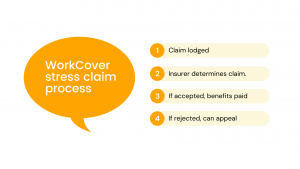Claiming WorkCover
Table of Contents
How to claim WorkCover
- Inform your employer about the injury, illness or condition (you should do so but if you don’t you can still make a claim).
- Complete the WorkCover claim form.
- Lodge the WorkCover claim form – either on the insurer, WorkSafe or your employer.
- Proceed with the claim determination process.
1. Let your employer know about the injury/illness/condition
You should let your employer know that you have suffered an injury related to your employment within 30 days of becoming aware of that injury.
Note however that if you don’t do so or haven’t done so, you can still claim WorkCover. Many people do not report their injuries to their employer and still successfully obtain WorkCover benefits.
You can read more about this further down the page.
2. Complete the WorkCover claim form
This is what (one page of) the WorkCover claim form looks like in Victoria.
Completing, signing and lodging this specific claim form is the only way that you are able to initiate a WorkCover claim in Victoria.
If you have not previously completed one of these forms then it is likely you do not have a WorkCover claim for a particular injury or condition.
If you’ve been told that a claim has been lodged on your behalf by someone but you haven’t signed this specific claim form, then it’s likely you do not have a claim.
It is also important to note that only you as the injured person is able to sign this claim form.
Others can lodge it on your behalf, but they cannot sign it.
Some people believe that by going to the doctor and getting a certificate of capacity that a WorkCover claim has been initiated.
This is not correct and you can read more about that here.
Completing the form
It is important that the WorkCover claim form be completed with care and attention.
It must be accurate.
Anything that you write on the claim form could possibly be used by the WorkCover insurer to reject your claim.
For example, if your injury is a gradual process injury (that is it is occurred over a period of time rather than on a specific occasion) but you write that it occurred as a result of a specific incident, in some instances your claim may be rejected.
Likewise, if you do not for example list any previous injuries – even though you believe they may not be relevant to the claim – your claim may be rejected.
So keep this in mind.
Anything that you write on the workers injury claim form can potentially be used by the WorkCover insurer to reject your claim.
If your claim is rejected this could mean that you may need to go to conciliation which can add another month or more to the processing time during which you are not entitled to be paid weekly payments of compensation from WorkCover if you are not able to work.
This is particularly relevant for casual workers given they don’t have any leave entitlements.
It’s also particularly relevant for those that may not have an adequate amount of sick leave, annual leave or long service leave to cover the claim determination period.
If the claim fails to resolve at conciliation, and many rejected claim matters do not, if you choose to pursue the matter further you’re potentially adding six months or more in terms of delay.
Many matters where a claim has been rejected will not resolve at conciliation.
Typically what the insurer may do is offer you to settle your claim for a limited period of weekly payments and/or medical and like expenses.
And even if your claim is accepted initially, whatever you write on the claim form can potentially be used by WorkCover or their lawyers any time during the life of your claim.
3. Lodge the WorkCover claim form
Once you have adequately completed the claim form and signed it, then it must be lodged.
A WorkCover claim can be lodged by:
- Sending the claim form to your employer
- Sending the claim form to the relevant WorkCover insurer (Allianz, EML, Gallagher Bassett, Xchanging)
- Sending the claim form directly to WorkSafe.
Most people will provide their claim form to their employer.
Some people however prefer to send it directly to the WorkCover insurer.
If there has been a breakdown in the employer/employee relationship and the WorkCover insurer is not known, then a small number of people will send the claim form directly to Worksafe.
Either way, the employer will be provided with a copy of the claim form.
They will need to complete their section on the claim form (you can see the relevant section at the end of the claim form).
They will then need to send the claim form off to the insurer for processing.
The law in Victoria says that a person must provide an employer a copy of the WorkCover claim form within 30 days of injury.
If a claim is provided outside 30 days in some instances it may be rejected on this basis.
However, the law also says that the 30 day period maybe extended if there are reasons as to why it was not reasonably practicable to lodge the claim and the reality is that a large number of WorkCover claims are lodged outside the 30 day period.
If your claim is going to be rejected, it is unlikely that it will be rejected solely on the basis of it being lodged outside the 30 day period.
Once the claim form has been lodged whether that be sent to the employer, insurer or WorkSafe, then you should record the date that this was done.
You should also receive a copy of the completed claim form once it has been signed by your employer.
4. Go through the claim determination process
What happens once the claim has been lodged is that that the insurer will acknowledge receipt of your claim.
They will send you a letter or an email.
You should receive this correspondence within a few days of your claim being received by them.
This means that if you do not receive this then potentially your has not been lodged on your behalf and you should follow things up.
Once the insurer receives the claim, they will organise an appointment for you to be medically assessed by a doctor that they choose.
This is called an independent medical examination (IME).
In some cases they will also organise a circumstance investigation report.
Once the claim has been processed and a decision has been made by the insurer, the insurer must give written notice of decision to either accept or reject the claim.
Once the claim has been processed, the insurer must give written notice of decision either accepting or rejecting the claim within 28 days after receiving it or within 28 days after receiving a medical certificate.
If your claim is accepted:
If your claim is accepted then you are entitled to receive medical expenses and if you are claiming them – and if you have provided a certificate or certificates – weekly payments.
You’re also entitled be back paid weekly payments.
The insurer will send you a letter confirming your claim has been accepted.
You may wish to proceed with an impairment lump sum claim or a common law lump sum claim down the track.
Note however that just because your WorkCover claim has been accepted does not mean you will automatically be entitled to claim lump sum compensation.
If your claim is rejected:
If your claim is rejected then should you wish to pursue the claim further you can either ask the insurer to perform an internal review or go to conciliation.
We recommend that you go straight to conciliation rather than having the insurer do an internal review.
What is WorkCover?
WorkCover is a type of insurance in Victoria. It provides benefits to workers that have been injured or developed an illness or condition that is in someway related to their employment.
The injury, illness or condition can occur in a single incident or over a period of time.
WorkCover is insurance
It is a requirement for employers in Victoria to have WorkCover insurance to cover their employees in the event that they suffer injury.
If a person does suffer and injury related to their employment, and they wish to pursue WorkCover benefits, these are the benefits they may have an entitlement to;
WorkCover claim time limit in Victoria
When it comes to lodging the WorkCover claim in Victoria there is no specific time frame in which this must be done.
If you suffer an injury, you should give your employer notice of the injury within 30 days after you become aware of it, if you do not do so, you may not be entitled to compensation.
This is important: just because you have not told your employer about your injury does not mean that you cannot claim WorkCover benefits.
There are in reality many reasons for the extension in the reporting requirement which can read about here.
What are the criteria for WorkCover claims in Victoria?
Below are the criteria that you must meet satisfy in order to have your WorkCover claim accepted:
- there needs to be a connection to Victoria
- an injury (which can be physical or mental) and
- you must be considered a worker under the act.
What types of injuries are covered by WorkCover?
Here is a list of some of the different types of injuries covered by WorkCover. Note that this list is not exhaustive:
- Lifting injuries
- Muscular injuries
- Temporary injuries
- Permanent injuries
- Asbestos related conditions
- Head injuries
- Repetitive sprain injuries
- Psychological injuries
- Cancer
- Hearing loss
- Injuries that occurred over a period of time
- Injuries that occurred in a single incident
- Aggravation injuries
- Consequential injuries
Conclusion
Claiming WorkCover can be done by following the steps below:
- Let your employer know about the injury, illness or condition (you should do so but if you don’t you can still make a claim).
- Complete the WorkCover claim form.
- Lodge the WorkCover claim form.
- Go through the claim determination process.
Once the insurer has determined your claim, they will send you correspondence advising you as to whether your claim has been accepted or rejected.
If your claim is accepted you can claim medical and like expenses, weekly payments and potentially an impairment lump sum and/or a common law lump sum.
If your claim is rejected you can appeal the decision to conciliation.









